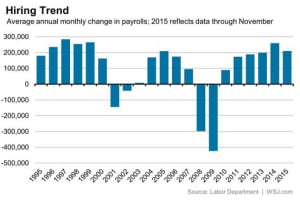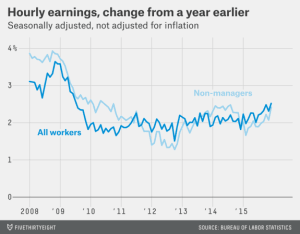What the jobs report doesn't tell us
More jobs are great. But that doesn't really show us if Americans are better off.


No question about it, the American economy ended 2015 with a bang.
According to Friday's jobs report, we added a spectacular 292,000 jobs in December. On top of that, the gains for October and November were both revised upward — to 307,000 and 252,000, respectively — for an additional 50,000 jobs. That brings the average for the last three months to 284,000 jobs per month. Other indicators like the unemployment rate and labor force participation didn't improve, but they didn't backslide either.
But this is also a good opportunity to talk about some of the difficulties around reporting on the economy, especially when it comes to the monthly jobs numbers. Because the reports come out in an incremental trickle every month, everyone can get in the habit of comparing them to what came immediately before, instead of to a truly healthy baseline.
The Week
Escape your echo chamber. Get the facts behind the news, plus analysis from multiple perspectives.

Sign up for The Week's Free Newsletters
From our morning news briefing to a weekly Good News Newsletter, get the best of The Week delivered directly to your inbox.
From our morning news briefing to a weekly Good News Newsletter, get the best of The Week delivered directly to your inbox.
For instance, 292,000 more jobs is spectacular compared to the rest of 2015, but the year as a whole averaged only 221,000 jobs per month. That's actually lower than the 260,000 per month we averaged in 2014, and it's considerably lower than the jobs created year after year during the economic boom of the late 1990s.

(Graph courtesy of the Wall Street Journal.)
But even that isn't the most important context.
We really want to know about the balance of forces in the economy. If everyone who wants a job can get one, if people are regularly switching jobs because they're confident other opportunities are out there, and if employers are worried about losing employees for the same reason, then workers have bargaining power: They can turn down job offers that aren't ideal without fear. That allows them to demand higher wages, and a bigger slice of the overall income generated by the economy, which in turn brings down inequality.
A free daily email with the biggest news stories of the day – and the best features from TheWeek.com
Job gains all by themselves don't show that, because they don't answer the questions How many jobs gained compared to how many people want work? or How many jobs gained compared to population growth? Similarly, the unemployment rate isn't necessarily helpful here either, because it's just the percentage of the labor force that's employed. The labor force is everyone who's either got a job or has been looking for one in the last four weeks. Bad recessions can knock people out of the labor force because the situation is just so bad that they give up. In that case, even if the unemployment rate goes down — it's currently at 5 percent — there's still a big pool of unemployed people out there holding down the bargaining power of people who are working.
The economy is a system and job gains, population growth, labor force participation, the unemployment rate, etc, are all inputs to that system. If the inputs improve, that's good! But what we really want to know are the outputs. And the output that probably gives us the best overall picture of the balance of forces in the economy — and whether enough people are finding jobs to really drive up worker bargaining power — is nominal wage growth itself.
In both the late 90s boom, and the peak just before the Great Recession, year-over-year wage growth topped out at around 4 percent. Ever since the 2008 collapse, it's bounced around at a measly 2 percent. But in the last few months it began to tick up. It hit 2.5 percent in December.
That's really the best news, buried down deep at the bottom of the jobs report, under the job gains and the unemployment rate: We're still a long way from 4 percent, but we have what looks like the makings of genuine upward trend.

(Graph courtesy of FiveThirtyEight.)
The only way this could be happening is if we're not just adding more jobs, but we're actually getting closer to maxing out the economy's total capacity for jobs. The closer we get to that maximum the more bottom-up pressure we create on wages throughout the economy.
Now, the bad news is how far below fully maxing out the economy's employment capacity we still are, and how long it may still take to get there. Back at the start of 2015, the Economic Policy Institute estimated we'd need to average 246,000 jobs a month in order to return to the balance of forces we enjoyed at the peak just before the 2008 crash. And even then we wouldn't get there until the summer of 2017.
But enough gloom. We've got a long slog before us and trends can always nose-dive — this is true. But for the moment, the wage trend is looking up. And that's a good way to start 2016.
Jeff Spross was the economics and business correspondent at TheWeek.com. He was previously a reporter at ThinkProgress.
-
 Political cartoons for December 7
Political cartoons for December 7Cartoons Sunday’s political cartoons include the Trump-tanic, AI Santa, and the search for a moderate Republican
-
 Trump’s poll collapse: can he stop the slide?
Trump’s poll collapse: can he stop the slide?Talking Point President who promised to ease cost-of-living has found that US economic woes can’t be solved ‘via executive fiat’
-
 Codeword: December 7, 2025
Codeword: December 7, 2025The daily codeword puzzle from The Week
